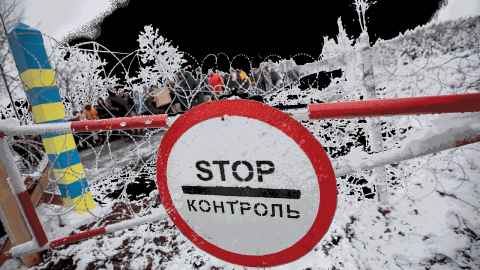Is letting a sleeping dog lie always the right answer?
27 February 2022
Opinion: Ritesh Shah saw the already existing humanitarian crisis in East Ukraine firsthand. Now he hopes the response to Russia's catastrophic invasion will match the scale and scope of the need.

This week we witnessed Ukraine being attacked by Russia from all directions, with a gasp of collective horror emanating from all of us in the “West”. For years, though, we ignored the fact that Ukraine was a country in conflict; one of the forgotten crises of the world.
Since 2014, the east of Ukraine has been locked in a struggle between the Ukrainian army and separatist rebels who took control of the Donetsk and Luhansk regions. Regions on either side of this border became immersed in a protracted conflict, with government forces and separatist rebels both trying to assert their authority over these contested lands.
In the period between 2014 and 2021, it was estimated by the United Nations Office for the Coordination of Humanitarian Affairs that nearly 3,400 civilians had died and at least 7,000 had been injured, many by shelling or land mines.
The conflict also led to the internal displacement of approximately 1.5 million people living on either side of the border, many who ended up in makeshift refugee camps on the outskirts of cities like Kharkiv or Kyiv.
Those living in this contested region, though, could not as easily forget the threat of war.
Until recently though, much of the world let this humanitarian crisis, with nearly 3.2 million in need, slip off the radar. As of December 2021, for example, only 56 percent of the humanitarian funding required for Ukraine had been committed by the international community, and this despite the fact that underpinning this conflict was a wider geopolitical battle between Russia and NATO.
Those living in this contested region, though, could not as easily forget the threat of war. In 2018, I travelled to some of the villages on the government-controlled side of the zone. I vividly remember walking into a school in Luhanskoe to speak to its principal.
As we walked down the wide, echoing hallway to her office, the walls suddenly shook, and there was a loud, distant boom.She turned to me, rather nonchalantly and said: “Shelling”. She estimated the explosion was about two kilometres from where we were standing.

She went on to describe how since the conflict started, her school had come under attack on three occasions, with classroom windows being blown out each time, and in one instance, a wall in the school destroyed.
Luckily students were not in school at any of these times. As of 2019, 750 educational facilities on both sides of the contact line had been destroyed or damaged due to hostilities, interrupting the schooling of children for months in some instances.
Even more concerning are the psychological scars this prolonged conflict has left on children. One mother, in the village of Valujske, recalled how “when the conflict came to our village, my family and I were trapped at home with heavy shelling going on outside. We sheltered in our basement over the harsh winter and intense shelling, without heating and water for several months.”
A few years later, and with tears welling in her eyes, she said the situation had had a profound effect on her and her children.
“We’ve lost our sense of hope for the future and become quite depressed. My son became quite short-tempered, aggressive, and withdrawn with me and the rest of the family. He lost any ability to communicate with others and when he does speak, he only talks about the war.”
Sadly, stories like this are commonplace across the buffer zone. At least 378,000 children needed protection and assistance on Ukraine’s front lines before Russia’s invasion began. Now, this will extend to millions more across the entire nation, with many seeking refuge in Western Europe.
To avoid the mistakes of the Syrian refugee crisis, a system will need to be in place for asylum-seekers, one which spreads the responsibility for receiving these refugees across the entire European Union.
As we witness Ukraine under attack now, let’s ensure the international humanitarian response is commensurate to the scale and scope of need, unlike the past. Neighbouring states with the support of the international community must provide these refugees with access to shelter, food and water, and education. In humanitarian crises, education is a life-saving and sustaining need, but remains poorly funded.
To avoid the mistakes of the Syrian refugee crisis, a system will need to be in place for asylum-seekers, one which spreads the responsibility for receiving these refugees across the entire European Union. New Zealand must also do its part and be a more welcoming place for some of those seeking asylum and permanent resettlement.
Lastly, while Ukraine may no longer be an invisible crisis, let’s remember there are many other crises at present that as an international community we pay little heed to until the sleeping dog awakes.
Dr Ritesh Shah is a senior lecturer in comparative and international education at the University of Auckland.
This article reflects the opinion of the author and not necessarily the views of the University of Auckland.
This piece first appeared in the Sunday Star-Times and Stuff on 27 February 2022.
Media contact
Julianne Evans | Media adviser
M: 027 562 5868
E: julianne.evans@auckland.ac.nz